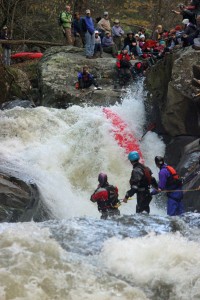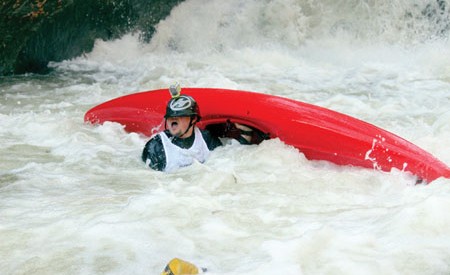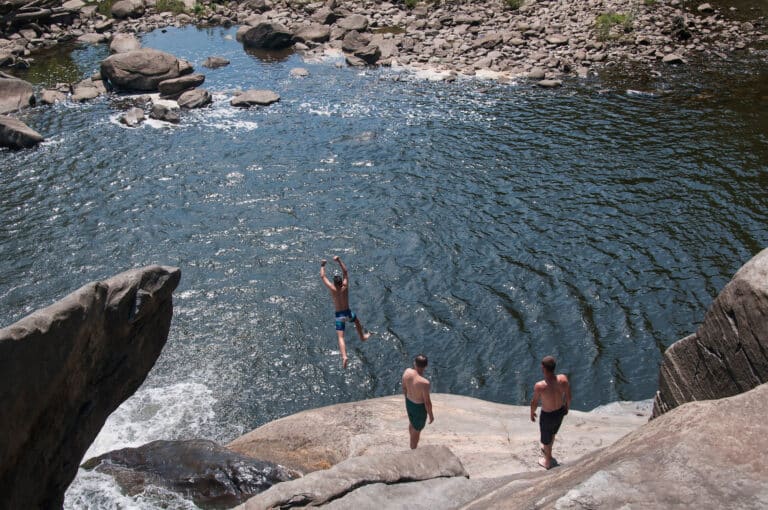The Green Race started as a legendary day in which a few local paddlers lined up at the top of the “monster mile” to test their personal limits and earn bragging rights. A self-regulated community, that elite group of paddlers was able to vet newcomers and make sure they weren’t getting in over their heads.
Now in its 18th year, that tight-knit style cannot be maintained with thousands of paddlers running the Green every year. As a result, there is a new term that I am hearing far too often in the same breath as Green Race: shit show.
Last year, I realized that I was more nervous spectating than I was racing. I sat below the crux of the race, Gorilla, and cringed as I witnessed some horrific lines. One after another, paddlers pinballed down, sometimes upright and sometimes on their heads. Many lacked basic kayak survival skills, like the ability to orient and drive their boat to safety, surf out of a hole, or even roll. I’m not sure what steps transpired to get them there, but had I been asked individually about their readiness for the Green Race, I would have told at least a third of the field that they should keep practicing and wait for another year. Fortunately, in spite of the bad lines and 20-plus swims, every paddler came out of the experience without injury.
Five-time women’s champion, Adriene Levknecht, sums up this trend well: “I’ve been racing the Green for seven years, and every year has been sketchier than the last.”
So, at the heart of it, why are people paddling over their ability levels?

Race organizer John Grace suggested one possibility. “The safety during Green Race day is unparalleled. That live bait rescue system is on display to all spectators and aspiring racers, and paddlers believe that no matter what happens on race day, ‘they’ve got me.’ This mentality breeds complacency, and paddlers do irresponsible things like run Gorilla for their first time ever on race day.”
Unqualified paddlers may also get drawn up in the energy and aura of the race. The put-in speech by figurehead Jason Hale is nothing short of legendary, and I can’t blame aspiring athletes who want a piece of that bedrock coliseum with 1000+ spectators. It’s easy to get drawn into this energy, especially when it involves peer pressure from buddies, and the desire to add that fantastic and universally recognizable accomplishment to the resume.
“The number of new competitors has consistently averaged 35% of total racers over the past five years,” says John Pilson, keeper of the Green Race Information Page. “I love the race so much, but during a time of alarming spike in whitewater fatalities, it’s unsettling to witness that carnage during race day.”
The issue is particularly precarious this year because of the high water levels. The Green could be at over two times the normal flow for the race. This is thrilling news for top athletes, but it does not bode well for the borderline racers. The river turns into a liquid locomotive: the holes get bigger, the rapids more continuous, and the ability to help paddlers in trouble drops dramatically. That safety net that so many rely on is simply not there at high water.
So what is the answer?
This challenge has been dealt with in other top-level races by creating an invitation board or a qualifying round. Races such as The North Fork Championship, Sickline World Championships, and the Whitewater Grand Prix all have some form of screening process before paddlers are allowed to compete. I can personally attest to the effectiveness of these steps, because those races all see minimal carnage.
While this is an option, part of the draw to the Green Race is its grassroots nature. This race has always been completely free to enter, has no cash on the line for the winner, and has no specific protocol for spectators, yet it is among the most prestigious races in the world to win. Grace sums up balancing that heritage with managing its growing pains:
“Every year, we tighten up the Green Race just a bit. Whether that is through insurance, safety, or media, we work to improve it so that it can be sustainable. After watching what happened last year, the next step may be some kind of intervention. If competitors can’t clean it up and self-regulate, our hand will be forced to create an application process.”
This is simple self-preservation. If unqualified racers continue to compete, math dictates that a serious accident or death is likely to occur. To protect organizers and the race itself, people must start making honest assessments about their own abilities to run the course smoothly under pressure. If they are incapable of doing this, other steps will be taken.
Of course, class V whitewater is inherently unpredictable, and no one can have smooth lines 100 percent of the time. I have swum during Green Race practice, and many great paddlers have done the same during the event. It happens sometimes. As Jeff Paine, racer and American Whitewater staffer says, “Even with several hundred laps on the Green, each year I think critically about my readiness to race. If I’m not ready, I could put myself, other competitors and safety crew in danger.”
Fortunately we have some incredible personalities in the sport who are leading the way. Rafa Ortiz recently announced that, in spite of huge investment of time and sponsorship dollars, his would-be first kayak descent of Niagara Falls didn’t feel right, and he was pulling the plug. Robin Betz, long-time Green Racer, decided at the last minute in 2008 that she didn’t feel right about racing, and chose to follow her gut and spectate instead. She was the defending champion at the time. These are the types of decisions that are overlooked, but are infinitely important for the next generation to hear and think about.
Paddlers call Green Race “the greatest show in sports.” It will continue to be a huge source of pride for its local community only if we can collectively work to glorify good decisions and honest self-assessment. Let’s race the Green at high water this fall, and let’s do it well.
The 18th annual Green Race will be held on Saturday, Nov. 2nd, 2013 at 12 noon.







